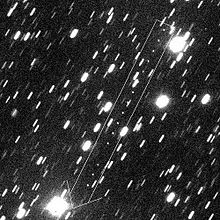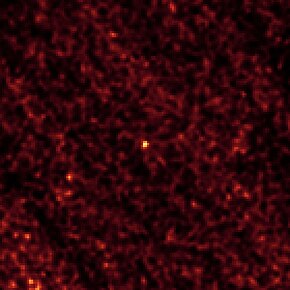|
2011 MD
2011 MD is a bright micro-asteroid, classified as near-Earth object of the Apollo and Amor group, respectively.[1][3] On 27 June 2011, at around 17:00 UTC (13:00 EDT), the object passed exceptionally close to Earth's surface at a distance of approximately 12,000 kilometers (7,500 mi), roughly the diameter of the Earth.[6][7][8] Description Although 2011 MD was initially believed to be space junk, subsequent observations confirmed that it is an asteroid. A few hours before the asteroid's nearest approach in 2011, it appeared close to the Sun, so observations were possible for only a brief period. Backyard astronomers were able to observe it with telescopes from Australia, southern Africa, and the Americas.[7] 2011 MD was discovered on 22 June 2011, by astronomers of the Lincoln Near-Earth Asteroid Research (LINEAR) at the U.S. Lincoln Laboratory Experimental Test Site in Socorro, New Mexico, by a pair of robotic telescopes. According to original rough estimates, the asteroid's length was between 10 and 45 meters (30 and 150 ft).[3][9] However, according to the more recent absolute magnitude (H) measurement of 28.1[1] and its albedo of 0.3, the asteroid is closer to 6 meters or 20 feet in diameter.[5] Emily Baldwin of Astronomy Now said that there was no threat of collision, and should the asteroid enter Earth's atmosphere, it would "mostly burn up in a brilliant fireball, possibly scattering a few meteorites", causing no likely harm to life or property on the ground.[9] The 27 June 2011 close approach to Earth increased the orbital period of 2011 MD from 380 days to 396 days. During close approach the asteroid passed Earth at a relative speed of 6.7 km/s[1] with a geocentric eccentricity of 1.1. 2011 MD was observed by the Spitzer Space Telescope in February 2014 and estimated to be 6 meters (20 ft) in diameter.[4] The asteroid is a porous rubble pile with a density similar to water.[4] On 19 June 2014, NASA reported that asteroid 2011 MD was a prime candidate for capture by the Asteroid Redirect Mission (ARM) in the early 2020s.[10]
GalleryTrajectory of 2011 MD projected onto the Earth's orbital plane. Note, from this viewing angle, the asteroid passes underneath the Earth. Trajectory of 2011 MD from the general direction of the Sun. Artist's concept of spacious structure of asteroid 2011 MD[11] See alsoReferences
External linksWikimedia Commons has media related to 2011 MD.
|
||||||||||||||||||||||||||||||||||||||||||||||||||||||||||||||||||||||||||||||||||||||||||||||||||||||||






